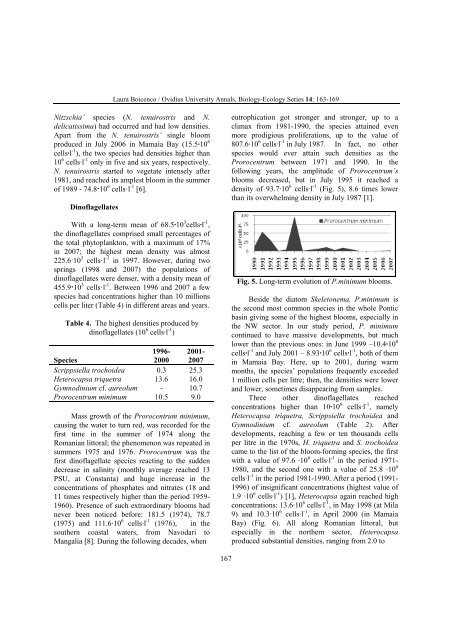VOLUM OMAGIAL - Facultatea de Ştiinţe ale Naturii şi Ştiinţe Agricole
VOLUM OMAGIAL - Facultatea de Ştiinţe ale Naturii şi Ştiinţe Agricole
VOLUM OMAGIAL - Facultatea de Ştiinţe ale Naturii şi Ştiinţe Agricole
You also want an ePaper? Increase the reach of your titles
YUMPU automatically turns print PDFs into web optimized ePapers that Google loves.
Laura Boicenco / Ovidius University Annals, Biology-Ecology Series 14: 163-169<br />
Nitzschia’ species (N. tenuirostris and N.<br />
<strong>de</strong>licatissima) had occurred and had low <strong>de</strong>nsities.<br />
Apart from the N. tenuirostris’ single bloom<br />
produced in July 2006 in Mamaia Bay (15.5∙10 6<br />
cells∙l -1 ), the two species had <strong>de</strong>nsities higher than<br />
10 6 cells∙l -1 only in five and six years, respectively.<br />
N. tenuirostris started to vegetate intensely after<br />
1981, and reached its amplest bloom in the summer<br />
of 1989 - 74.8·10 6 cells·l -1 [6].<br />
Dinoflagellates<br />
With a long-term mean of 68.5∙10 3 cells∙l -1 ,<br />
the dinoflagellates comprised small percentages of<br />
the total phytoplankton, with a maximum of 17%<br />
in 2007; the highest mean <strong>de</strong>nsity was almost<br />
225.6·10 3 cells·l -1 in 1997. However, during two<br />
springs (1998 and 2007) the populations of<br />
dinoflagellates were <strong>de</strong>nser, with a <strong>de</strong>nsity mean of<br />
455.9·10 3 cells·l -1 . Between 1996 and 2007 a few<br />
species had concentrations higher than 10 millions<br />
cells per liter (Table 4) in different areas and years.<br />
Table 4. The highest <strong>de</strong>nsities produced by<br />
dinoflagellates (10 6 cells∙l -1 )<br />
1996- 2001-<br />
Species<br />
2000 2007<br />
Scrippsiella trochoi<strong>de</strong>a 0.3 25.3<br />
Heterocapsa triquetra 13.6 16.0<br />
Gymnodinium cf. aureolum - 10.7<br />
Prorocentrum minimum 10.5 9.0<br />
Mass growth of the Prorocentrum minimum,<br />
causing the water to turn red, was recor<strong>de</strong>d for the<br />
first time in the summer of 1974 along the<br />
Romanian littoral; the phenomenon was repeated in<br />
summers 1975 and 1976. Prorocentrum was the<br />
first dinoflagellate species reacting to the sud<strong>de</strong>n<br />
<strong>de</strong>crease in salinity (monthly average reached 13<br />
PSU, at Constanta) and huge increase in the<br />
concentrations of phosphates and nitrates (18 and<br />
11 times respectively higher than the period 1959-<br />
1960). Presence of such extraordinary blooms had<br />
never been noticed before: 181.5 (1974), 78.7<br />
(1975) and 111.6∙10 6 cells∙l -1 (1976), in the<br />
southern coastal waters, from Navodari to<br />
Mangalia [8]. During the following <strong>de</strong>ca<strong>de</strong>s, when<br />
167<br />
eutrophication got stronger and stronger, up to a<br />
climax from 1981-1990, the species attained even<br />
more prodigious proliferations, up to the value of<br />
807.6∙10 6 cells∙l -1 in July 1987. In fact, no other<br />
species would ever attain such <strong>de</strong>nsities as the<br />
Prorocentrum between 1971 and 1990. In the<br />
following years, the amplitu<strong>de</strong> of Prorocentrum’s<br />
blooms <strong>de</strong>creased, but in July 1995 it reached a<br />
<strong>de</strong>nsity of 93.7∙10 6 cells∙l -1 (Fig. 5), 8.6 times lower<br />
than its overwhelming <strong>de</strong>nsity in July 1987 [1].<br />
Fig. 5. Long-term evolution of P.minimum blooms.<br />
Besi<strong>de</strong> the diatom Skeletonema, P.minimum is<br />
the second most common species in the whole Pontic<br />
basin giving some of the highest blooms, especially in<br />
the NW sector. In our study period, P. minimum<br />
continued to have massive <strong>de</strong>velopments, but much<br />
lower than the previous ones: in June 1999 –10.4∙10 6<br />
cells∙l -1 and July 2001 – 8.93∙10 6 cells∙l -1 , both of them<br />
in Mamaia Bay. Here, up to 2001, during warm<br />
months, the species’ populations frequently excee<strong>de</strong>d<br />
1 million cells per litre; then, the <strong>de</strong>nsities were lower<br />
and lower, sometimes disappearing from samples.<br />
Three other dinoflagellates reached<br />
concentrations higher than 10∙10 6 cells∙l -1 , namely<br />
Heterocapsa triquetra, Scrippsiella trochoi<strong>de</strong>a and<br />
Gymnodinium cf. aureolum (Table 2). After<br />
<strong>de</strong>velopments, reaching a few or ten thousands cells<br />
per litre in the 1970s, H. triquetra and S. trochoi<strong>de</strong>a<br />
came to the list of the bloom-forming species, the first<br />
with a value of 97.6 ∙10 6 cells∙l -1 in the period 1971-<br />
1980, and the second one with a value of 25.8 ∙10 6<br />
cells∙l -1 in the period 1981-1990. After a period (1991-<br />
1996) of insignificant concentrations (highest value of<br />
1.9 ∙10 6 cells∙l -1 ) [1], Heterocapsa again reached high<br />
concentrations: 13.6∙10 6 cells∙l -1 , in May 1998 (at Mila<br />
9) and 10.3∙10 6 cells∙l -1 , in April 2000 (in Mamaia<br />
Bay) (Fig. 6). All along Romanian littoral, but<br />
especially in the northern sector, Heterocapsa<br />
produced substantial <strong>de</strong>nsities, ranging from 2.0 to





